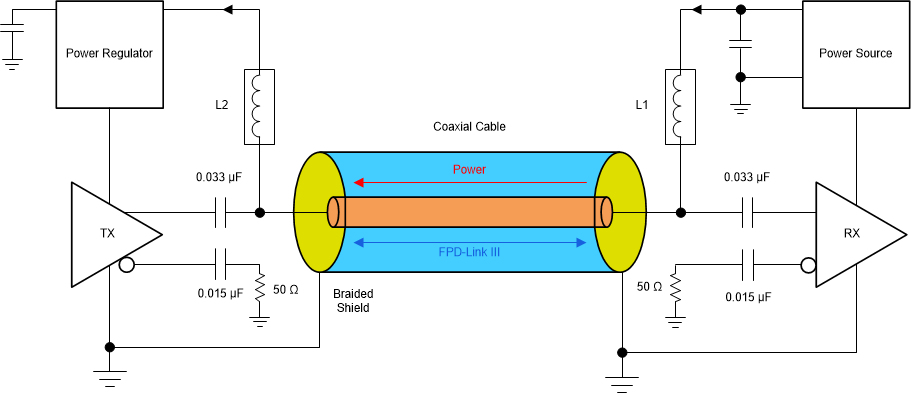TIDUF05 August 2022
- Description
- Resources
- Features
- Applications
- 5
- 1System Description
- 2System Overview
- 3Hardware, Testing Requirements, and Test Results
- 4Design and Documentation Support
- 5Documentation Support
- 6Support Resources
- 7Trademarks
2.2.2.1 POC Filter
One of the most critical portions of a design that uses POC is the filter circuitry. The goal is twofold:
- Deliver a clean DC supply to the input of the switching regulators.
- Protect the FPD-Link communication channels from noise-coupled backwards from the rest of the system.
The DS90UB953-Q1 and DS90UB960-Q1 SerDes devices used in this system communicate over two carrier frequencies, 2 GHz at full speed (forward channel) and a lower frequency of 50 MHz (backchannel) determined by the deserializer device. The filter must attenuate this rather large band spanning both carriers, hoping to pass only DC. An impedance of > 2 kΩ across the 25-MHz to 2-GHz bandwidth is required to allow the forward channel and back channel to pass uninterrupted over coax. To accomplish this, an inductor is typically chosen for filtering the 25-MHz to 1-GHz range, while a ferrite bead is chosen for filtering the 1- to 2-GHz frequency band. This complete filter is shown by L2 in Figure 2-4. L1 would be the same but its POC filter for the deserializer side of the FPD-Link III transmission. In this camera design, it is critical for the POC filter to have the smallest footprint possible. To accomplish this, the LQH3NPZ100MJRL 10-µH inductor is chosen because it has a wide band impedance that filters from 10 MHz to 1 GHz. This eliminates the need for a solution that would typically require two inductors, one for the lower frequency and another for the higher frequency.
For the high-frequency forward-channel filtering, this reference design uses three 1.5-kΩ ferrite beads in series with the 10-µH inductor to bring the impedance above 2 kΩ across the 1- to 2-GHz range. This design uses three 1.5-kΩ ferrite beads because when in operation, the current through these devices reduces the effective impedance. Therefore three ferrite beads instead of two allows for more headroom across the whole frequency band. For good measure, this design uses a 4-kΩ resistor in parallel with the 10-µH inductor to provide a constant impedance across the complete frequency band for impedance smoothing. With this approach, the solution size can be minimized onboard for the PoC inductor filtering. For more details, see the Power Over Coax Design Guidelines for DS90UB953-Q1 application report.
Lastly, in regards to filtering, ensuring that the FPD-Link signal is uninterrupted is just as important as providing a clean, noise-free DC supply to the system. To achieve this, AC coupling capacitors shown by the 0.033 µF and 0.015 µF are chosen to ensure the high-speed AC data signals are passed through but that the DC is blocked from getting on the data lines. A smaller capacitance is possible for the DS90UB953-Q1 and DS90UB954-Q1 devices compared to previous generations due to the increased back channel speed.
 Figure 2-4 Power Over Coax
Figure 2-4 Power Over Coax